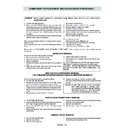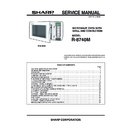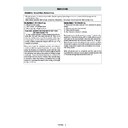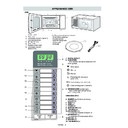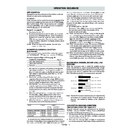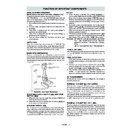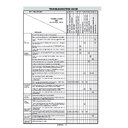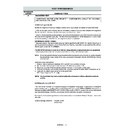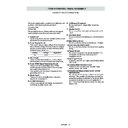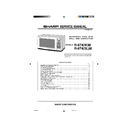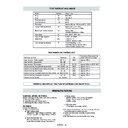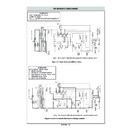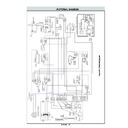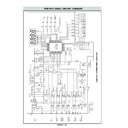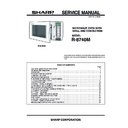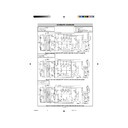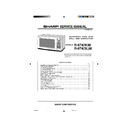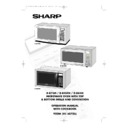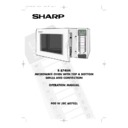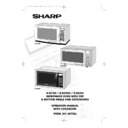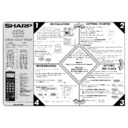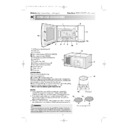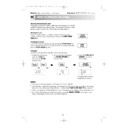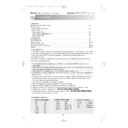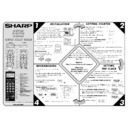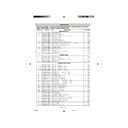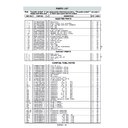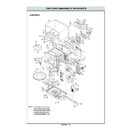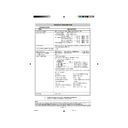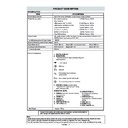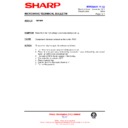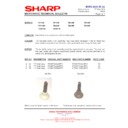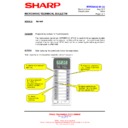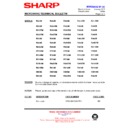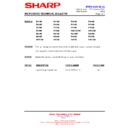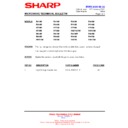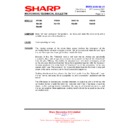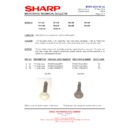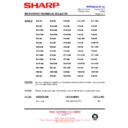Sharp R-874 (serv.man3) Service Manual ▷ View online
R-874M - 21
LSI(IXA094DR)
The I/O signal of the LSI(IXA094DR) are detailed in the following table.
The I/O signal of the LSI(IXA094DR) are detailed in the following table.
DESCRIPTION OF LSI
Pin No.
Signal
I/O
Description
Power output
ON time
OFF time
100 %
48 sec.
0 sec.
90 %
44 sec.
4 sec.
80 %
40 sec.
8 sec.
70 %
36 sec.
12 sec.
60 %
32 sec.
16 sec.
50 %
26 sec.
22 sec.
40 %
22 sec.
26 sec.
30 %
16 sec.
32 sec.
20 %
12 sec.
36 sec.
10 %
8 sec.
40 sec.
ON
OFF
During
cooking
L
GND
H.
(Convection or dual cooking)
ON
OFF
During cooking or for awhile after convection,
grill (top and bottom grill ) or dual.
grill (top and bottom grill ) or dual.
L
GND
H.
38
XIN
IN
Internal clock oscillation frequency input setting.
The internal clock frequency is set by inserting the ceramic filter oscillation circuit
with respect to XOUT terminal.
The internal clock frequency is set by inserting the ceramic filter oscillation circuit
with respect to XOUT terminal.
39
XOUT
OUT
Internal clock oscillation frequency control output.
Output to control oscillation input of XIN.
Output to control oscillation input of XIN.
40
VSS
IN
Power source voltage: -5V.
VC voltage of power source circuit input.
VC voltage of power source circuit input.
41
P27
OUT
Bottom heating element driving signal.
To turn on and off the relay (RY4). "L"
level during grill cooking, convection
cooking or dual cooking, "H" level
otherwise.
The heater relay turns on and off within
a 48 second time base in accordance
with the special program in LSI.
To turn on and off the relay (RY4). "L"
level during grill cooking, convection
cooking or dual cooking, "H" level
otherwise.
The heater relay turns on and off within
a 48 second time base in accordance
with the special program in LSI.
42
P26
OUT
Convection motor driving signal.
To turn on and off shut-off relay(RY7). "L"
level during convection or dual cooking "H"
level otherwise. (Relay RY7 does not turn on
at preheating mode.)
To turn on and off shut-off relay(RY7). "L"
level during convection or dual cooking "H"
level otherwise. (Relay RY7 does not turn on
at preheating mode.)
43
P25
OUT
Fan motor driving signal.
To turn on and off the fan motor relay RY6. "L"
level during cooking, or for a while after
convection, grill (top and bottom grill) or dual
cooking. "H" level otherwise.
To turn on and off the fan motor relay RY6. "L"
level during cooking, or for a while after
convection, grill (top and bottom grill) or dual
cooking. "H" level otherwise.
44
P24
OUT
Terminal not used.
45
P23
OUT
Touch control transformer driving signal.
To turn on and off the shut off relay (RY5). If the oven has not been used for more
than 3 minutes, the relay RY5 will be turned off. The relay RY5 will be turned on
when the oven door is opened and closed.
To turn on and off the shut off relay (RY5). If the oven has not been used for more
than 3 minutes, the relay RY5 will be turned off. The relay RY5 will be turned on
when the oven door is opened and closed.
46-48
P22-P20
OUT
Terminal not used.
49-50
P17-P16
IN
Terminal to change functions according to the model.
51-80
SEG39-SEG10
OUT
Segment data signal.
Connected to LCD.
The relation between signals are as follows:
Connected to LCD.
The relation between signals are as follows:
LSI signal (Pin No.)
LCD (Pin No.)
LSI signal (Pin No.) LCD (Pin No.)
SEG 0 (90) .................... SEG39 (51)
SEG21 (69) ................. SEG19 (19)
SEG 1 (89) .................... SEG38 (50)
SEG22 (68) ................. SEG18 (18)
SEG 2 (88) .................... SEG37 (49)
SEG23 (67) ................. SEG17 (17)
SEG 3 (87) .................... SEG36 (48)
SEG24 (66) ................. SEG16 (16)
SEG 4 (86) .................... SEG35 (47)
SEG25 (65) ................. SEG15 (15)
SEG 5 (85) .................... SEG34 (46)
SEG26 (64) ................. SEG14 (14)
SEG 6 (84) .................... SEG33 (45)
SEG27 (63) ................. SEG13 (13)
SEG 7 (83) .................... SEG32 (44)
SEG28 (62) ................. SEG12 (12)
SEG 8 (82) .................... SEG31 (43)
SEG29 (61) ................. SEG11 (11)
SEG10 (80) ................... SEG30 (30)
SEG30 (60) ................. SEG10 (10)
SEG11 (79) ................... SEG29 (29)
SEG31 (59) ................... SEG 9 ( 9)
SEG12 (78) ................... SEG28 (28)
SEG32 (58) ................... SEG 8 ( 8)
SEG13 (77) ................... SEG27 (27)
SEG33 (57) ................... SEG 7 ( 7)
SEG14 (76) ................... SEG26 (26)
SEG34 (56) ................... SEG 6 ( 6)
SEG15 (75) ................... SEG25 (25)
SEG35 (55) ................... SEG 5 ( 5)
SEG16 (74) ................... SEG24 (24)
SEG36 (54) ................... SEG 4 ( 4)
SEG17 (73) ................... SEG23 (23)
SEG37 (53) ................... SEG 3 ( 3)
SEG18 (72) ................... SEG22 (22)
SEG38 (52) ................... SEG 2 ( 2)
SEG19 (71) ................... SEG21 (21)
SEG39 (51) ................... SEG 1 ( 1)
SEG20 (70) ................... SEG20 (20)
R-874 S/MANUAL
11/7/01, 10:59 am
21
R-874M - 22
Pin No.
Signal
I/O
Description
81
SEG9
OUT
Terminal not used.
82-90
SEG8-SEG0
OUT
Segment data signal.
Connected to LCD. Signal is similar to SEG39.
Connected to LCD. Signal is similar to SEG39.
91
VCC
IN
Connected to GND.
92
VREF
IN
Connected to GND.
93
AVSS
IN
Connected to VC.
94
COM3
OUT
Common data signal: COM3.
Connected to LCD (Pin No. 35).
Connected to LCD (Pin No. 35).
95
COM2
OUT
Common data signal: COM2.
Connected to LCD (Pin No. 34).
Connected to LCD (Pin No. 34).
96
COM1
OUT
Common data signal: COM1.
Connected to LCD (Pin No. 33).
Connected to LCD (Pin No. 33).
97
COM0
OUT
Terminal not used.
98-99
VL3-VL2
IN
Power source voltage input terminal.
Standard voltage for LCD.
Standard voltage for LCD.
100
C2
IN
Terminal not used.
LSI(IXA094DR)
The I/O signal of the LSI(IXA094DR) are detailed in the following table.
The I/O signal of the LSI(IXA094DR) are detailed in the following table.
DESCRIPTION OF LSI
R-874 S/MANUAL
11/7/01, 10:59 am
22
R-874M - 23
SERVICING
5) Re-connect the power supply cord after the outer
case is installed.
6) Run the oven and check all functions.
A.
On some models, the power supply cord between the
touch control panel and the oven itself is so short that
the two can't be separated.
the two can't be separated.
For those models, check and repair all the controls
(sensor-related ones included) of the touch control
panel while keeping it connected to the oven.
(sensor-related ones included) of the touch control
panel while keeping it connected to the oven.
B.
On some models, the power supply cord between the
touch control panel and the oven is long enough that
they may be separated from each other. For those
models, therefore, it is possible to check and repair the
controls of the touch control panel while keeping it apart
from the oven; in this case you must short both ends of
the door sensing switch (on PWB) of the touch control
panel with a jumper, which brings about an operational
state that is equivalent to the oven door being closed.
As for the sensor-related controls of the touch control
panel, checking them is possible if the dummy resistor(s)
with resistance equal to that of the controls are used.
they may be separated from each other. For those
models, therefore, it is possible to check and repair the
controls of the touch control panel while keeping it apart
from the oven; in this case you must short both ends of
the door sensing switch (on PWB) of the touch control
panel with a jumper, which brings about an operational
state that is equivalent to the oven door being closed.
As for the sensor-related controls of the touch control
panel, checking them is possible if the dummy resistor(s)
with resistance equal to that of the controls are used.
(2) Servicing the touch control panel with power
supply from an external power source:
Disconnect the touch control panel completely from
the oven, and short both ends of the door sensing
switch (on PWB) of the touch control panel, which
brings about an operational state that is equivalent to
the oven door being closed. Connect an external
power source to the power input terminal of the touch
control panel, then it is possible to check and repair the
controls of the touch control panel; it is also possible to
check the sensor-related controls of the touch control
panel by using the dummy resistor(s).
the oven, and short both ends of the door sensing
switch (on PWB) of the touch control panel, which
brings about an operational state that is equivalent to
the oven door being closed. Connect an external
power source to the power input terminal of the touch
control panel, then it is possible to check and repair the
controls of the touch control panel; it is also possible to
check the sensor-related controls of the touch control
panel by using the dummy resistor(s).
4. Servicing Tools
Tools required to service the touch control panel assem-
bly.
1) Soldering iron: 30W
bly.
1) Soldering iron: 30W
(It is recommended to use a soldering iron with a
grounding terminal.)
grounding terminal.)
2) Oscilloscope: Single beam, frequency range: DC -
10MHz type or more advanced model.
3) Others: Hand tools
5. Other Precautions
1) Before turning on the power source of the control unit,
remove the aluminium foil applied for preventing static
electricity.
electricity.
2) Connect the connector of the key unit to the control unit
being sure that the lead wires are not twisted.
3) After aluminium foil is removed, be careful that abnor-
mal voltage due to static electricity etc. is not applied
to the input or output terminals.
to the input or output terminals.
4) Attach connectors, electrolytic capacitors, etc. to PWB,
making sure that all connections are tight.
5) Be sure to use specified components where high
precision is required.
E
C B
Transistor
2SB1238
2SB1238
Transistor
KRC243M
KRC243M
E
C
B
1. Precautions for Handling Electronic Components
This unit uses CMOS LSI in the integral part of the circuits.
When handling these parts, the following precautions
should be strictly followed. CMOS LSI have extremely
high impedance at its input and output terminals. For this
reason, it is easily influenced by the surrounding high
voltage power source, static electricity charge in clothes,
etc., and sometimes it is not fully protected by the built-in
protection circuit.
In order to protect CMOS LSI.
1) When storing and transporting, thoroughly wrap them
When handling these parts, the following precautions
should be strictly followed. CMOS LSI have extremely
high impedance at its input and output terminals. For this
reason, it is easily influenced by the surrounding high
voltage power source, static electricity charge in clothes,
etc., and sometimes it is not fully protected by the built-in
protection circuit.
In order to protect CMOS LSI.
1) When storing and transporting, thoroughly wrap them
in aluminium foil. Also wrap PW boards containing
them in aluminium foil.
them in aluminium foil.
2) When soldering, ground the technician as shown in
the figure and use grounded soldering iron and work
table.
table.
approx. 1M ohm
2. Shapes of Electronic Components
3. Servicing of Touch Control Panel
We describe the procedures to permit servicing of the
touch control panel of the microwave oven and the pre-
cautions you must take when doing so.
To perform the servicing, power to the touch control panel
is available either from the power line of the oven itself or
from an external power source.
touch control panel of the microwave oven and the pre-
cautions you must take when doing so.
To perform the servicing, power to the touch control panel
is available either from the power line of the oven itself or
from an external power source.
(1) Servicing the touch control panel with power
supply of the oven :
CAUTION:
THE HIGH VOLTAGE TRANSFORMER OF THE
MICROWAVE OVEN IS STILL LIVE DURING
SERVICING AND PRESENTS A HAZARD .
THE HIGH VOLTAGE TRANSFORMER OF THE
MICROWAVE OVEN IS STILL LIVE DURING
SERVICING AND PRESENTS A HAZARD .
T
herefore, before checking the performance of the touch
control panel,
1) Disconnect the power supply cord, and then remove
1) Disconnect the power supply cord, and then remove
outer case.
2) Open the door and block it open.
3) Discharge high voltage capacitor.
4) Disconnect the leads to the primary of the power
3) Discharge high voltage capacitor.
4) Disconnect the leads to the primary of the power
transformer.
5) Ensure that these leads remain isolated from other
components and oven chassis by using insulation
tape.
tape.
6) After that procedure, re-connect the power supply
cord.
After checking the performance of the touch control
panel,
1) Disconnect the power supply cord.
2) Open the door and block it open.
3) Re-connect the leads to the primary of the power
2) Open the door and block it open.
3) Re-connect the leads to the primary of the power
transformer.
4) Re-install the outer case (cabinet).
R-874 S/MANUAL
11/7/01, 10:59 am
23
R-874M - 24
9. Discharge the H.V. capacitor before carrying out any
further work.
10.Do not operate the oven with the outer case removed.
N.B.; Step 1, 2 and 9 form the basis of the 3D checks.
N.B.; Step 1, 2 and 9 form the basis of the 3D checks.
CAUTION: DISCHARGE HIGH VOLTAGE CAPACI-
TOR BEFORE TOUCHING ANY OVEN
COMPONENT OR WIRING.
COMPONENT OR WIRING.
CAUTION: WHEN THE OUTER CASE CABINET IS
RE-INSTALLED, INSTALL IT BEFORE THE
BACK PLATE IS INSTALLED, OR THE
OUTER CASE CABINET WILL BE DE-
FORMED.
BACK PLATE IS INSTALLED, OR THE
OUTER CASE CABINET WILL BE DE-
FORMED.
COMPONENT REPLACEMENT AND ADJUSTMENT PROCEDURE
WARNING: Avoid possible exposure to microwave energy. Please follow the instructions below
before operating the oven.
1. Disconnect oven from power supply.
2. Make sure that a definite “click” can be heard when the
2. Make sure that a definite “click” can be heard when the
microwave oven door is unlatched. (Hold the door in a
closed position with one hand, then push the door open
button with the other, this causes the latch leads to rise,
it is then possible to hear a “click” as the door switches
operate.)
closed position with one hand, then push the door open
button with the other, this causes the latch leads to rise,
it is then possible to hear a “click” as the door switches
operate.)
3. Visually check the door and cavity face plate for dam-
age (dents, cracks, signs of arcing etc.).
Carry out any remedial work that is necessary before
operating the oven.
Do not operate the oven if any of the following conditions
exist;
operating the oven.
Do not operate the oven if any of the following conditions
exist;
1. Door does not close firmly.
2. Door hinge, support or latch hook is damaged.
3. The door gasket or seal or damaged.
4. The door is bent or warped.
5. There are defective parts in the door interlock system.
6. There are defective parts in the microwave generating
2. Door hinge, support or latch hook is damaged.
3. The door gasket or seal or damaged.
4. The door is bent or warped.
5. There are defective parts in the door interlock system.
6. There are defective parts in the microwave generating
and transmission assembly.
7. There is visible damage to the oven.
Do not operate the oven:
1. Without the RF gasket (Magnetron).
2. If the wave guide or oven cavity are not intact.
3. If the door is not closed.
4. If the outer case (cabinet) is not fitted.
1. Without the RF gasket (Magnetron).
2. If the wave guide or oven cavity are not intact.
3. If the door is not closed.
4. If the outer case (cabinet) is not fitted.
Please refer to ‘OVEN PARTS, CABINET PARTS, CONTROL PANEL PARTS, DOOR PARTS’, when carrying out any
of the following removal procedures:
of the following removal procedures:
WARNING FOR WIRING
To prevent an electric shock, take the following
manners.
1. Before wiring,
manners.
1. Before wiring,
1) Disconnect the power supply.
2) Open the door and wedge the door open.
3) Discharge the high voltage capacitor and wait for
2) Open the door and wedge the door open.
3) Discharge the high voltage capacitor and wait for
60 seconds.
2. Don't let the wire leads touch to the following parts;
1) High voltage parts:
Magnetron, High voltage transformer, High volt-
age capacitor and High voltage rectifier assem-
bly.
age capacitor and High voltage rectifier assem-
bly.
2) Hot parts:
Top heating element, Bottom heating element,
Oven lamp, Magnetron, High voltage transformer
and Oven cavity.
and Oven cavity.
3) Sharp edge:
Bottom plate, Oven cavity, Waveguide flange,
Chassis support and other metallic plate.
Chassis support and other metallic plate.
4) Movable parts (to prevent a fault)
Fan blade, Fan motor, Switch, Open lever, Open
button,Turntable motor, Convection motor.
button,Turntable motor, Convection motor.
3. Do not catch the wire leads in the outer case cabinet.
4. Insert the positive lock connector certainly until its pin
4. Insert the positive lock connector certainly until its pin
is locked. And make sure that the wire leads should
not come off even if the wire leads is pulled.
not come off even if the wire leads is pulled.
5. To prevent an error function, connect the wire leads
correctly, referring to the Pictorial Diagram.
voltage capacitor.
3. Disconnect the high voltage wire B from the magnetron.
4. Remove one (1) screw holding earth side terminal of
4. Remove one (1) screw holding earth side terminal of
the high voltage rectifier assembly.
OUTER CASE REMOVAL
To remove the outer case proceed as follows.
1. Disconnect oven from power supply.
2. Open the oven door and wedge it open.
3. Remove the two (2) screws holding the back plate to
1. Disconnect oven from power supply.
2. Open the oven door and wedge it open.
3. Remove the two (2) screws holding the back plate to
the oven cavity rear plate. Remove the back plate
4. Remove the one (1) screw holding the air duct assem-
bly to the oven cavity rear plate.
5. Remove the air duct assembly
6. Remove the eight (8) screws from rear and along the
6. Remove the eight (8) screws from rear and along the
side edge of case.
7. Slide the entire case back about 3 cm to free it from
retaining clips on the cavity face plate.
8. Lift the entire case from the oven.
HIGH VOLTAGE COMPONENTS REMOVAL
(HIGH VOLTAGE CAPACITOR AND HIGH VOLTAGE RECTIFIER ASSEMBLY)
To remove the components, proceed as follows.
1. CARRY OUT 3D CHECKS.
2. Disconnect the filament lead of the high voltage trans-
1. CARRY OUT 3D CHECKS.
2. Disconnect the filament lead of the high voltage trans-
former and the high voltage wire A from the high
R-874 S/MANUAL
11/7/01, 10:59 am
24


